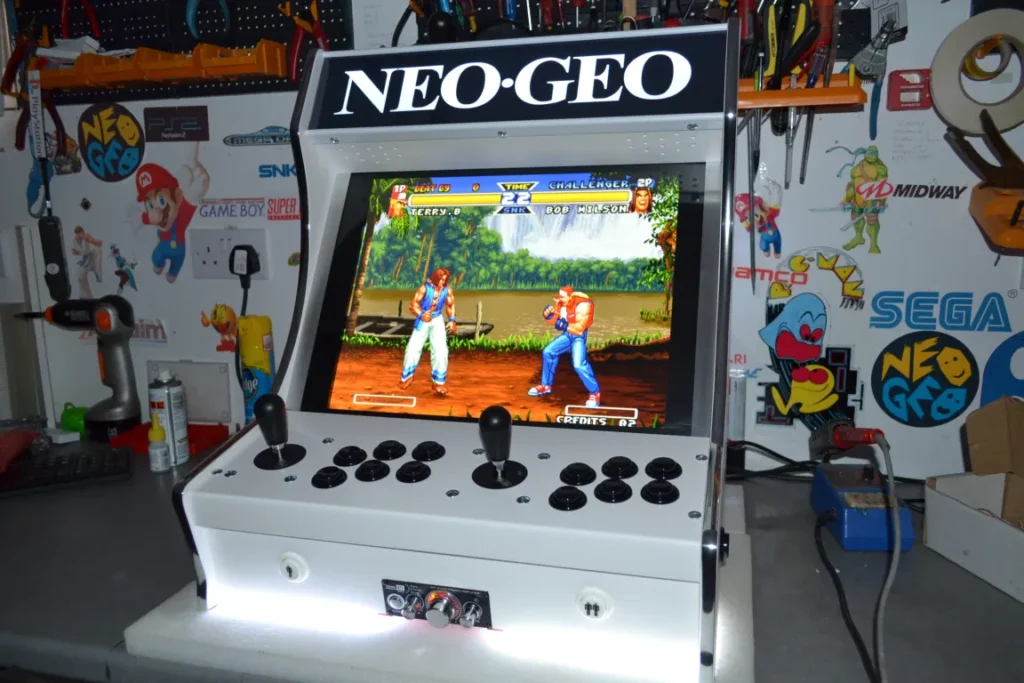Home » Raspberry-Pi Mini
Raspberry Pi Mini Arcade
A Raspberry Pi mini arcade is essentially a customized gaming system that emulates classic arcades using the Raspberry Pi as the central processing unit.
Raspberry Pi Mini Arcade -Two Player


PRICE: starting at 579 Euros (128GB).
Options available:
1. Genuine Japanese Sanwa Joysticks +buttons – 89 Euros
2. Illuminated buttons LED T10 (NOT Sanwa) – 97 Euros
Two player -19″, 4:3 monitor
Available in one player machine as well ( Check below).
The same cabinet used in the mini arcade machines two player Elite series and the Jamma Pandor box, is used in this machine.
– 27K+ games from different systems( check below).
- IPS Professional 4:3 monitor with low response time, vivid color and 178 degree view angle.
– USB connector
- HDMI out (after remove the monitor hdmi)
- audio out jack
WEIGHT: 14,2 kG DIMENSIONS: H: 576mm ; W: 477mm ; D: 415mm
Attract Mode frontend and custom Motion Blue build from scratch.
– you can add games to favorite
– Samsung or SanDisk 128 GB Micro SD card class 10
– save progress of a game in system supported
– more than 30 retro shaders to emulate different CRT monitor scanlines and so that can be change from control panel in most systems
-the key input configuration was setup in the best way possible to cover all systems .
Game list:
Amiga 4323
Atari 2600 649
Atari 7800 60
Atari Lynx 79
Commodore 64 598
Daphne 18
FBA 3071
Famincom 90
Gamegear 250
Gameboy 565
GBA 1105
GBC 536
Sega Genesis/MD 785
MAME ADV. 6195
MAME Libretro 4869
Sega Master S. 282
MSX 568
MSX2 85
N64 312
Neo-Geo 155
NES 792
Neo-Geo Pocket 9
Neo-Geo Poc.col.39
PC Engine 292
PLaystation 25
Sega32 34
Sega CD 26
SFC 489
SNES 789
SG1000 69
VirtualBoy 24
Wanderswan 114
Wanderswan col. 94
………………….
TOTAL 27099
Raspberry Pi Mini Arcade -One Player







Raspberry Pi Mini Arcade Plug and Play Retro video game machine
One player 10″, 4:3 monitor
Raspberry Pi Mini Arcade retro Machine Plug&Play
– 8 bit , 16bit and 32 bit glory …revived the best gaming era of all time.
– Plug and Play
– Easy to use
– Save progress in most systems.
- Arcade Genuine Japanese Sanwa Joysticks and silent golden leaf high performance buttons for perfect gameplay
– Available in one or two player:
– four USB connectors come as standard .
WEIGHT: 3,1 kG DIMENSIONS: H: 291mm ; W: 275mm ; D: 261mm
Price € 359 (128 GB)
Building Your Own Retro Gaming System
A Raspberry Pi mini arcade is essentially a customized system that emulates classic arcades using the Raspberry Pi as the central processing unit. This small computer, with its small form factor and powerful capabilities, serves as a cost-effective solution to run game emulators and manage the libraries.You can connect the small board to a monitor or TV and utilizing controllers, buttons, and other components, and you can recreate the nostalgic retro experience of raspberry pi mini arcade right in your own homes.
Components Required:
You will need a Raspberry Pi and a MicroSD Card: Choose a high-capacity microSD card to store the operating system, gaming software, and ROMs.
The arcade cabinet Controls include joysticks, buttons, and keyboard encoders. Arcade control kits are available online, providing multiple options. Then connect the Raspberry Pi to a monitor or TV with the HDMI connection.
Power Supply: Ensure you purchase an original 5V, 2,3 amps power supply to avoid shutdowns or even damage.
Audio Components: Add speakers or headphones for sound output.
Build Your Raspberry Pi Mini Arcade
Configure the emulator settings and controller inputs for optimal game play.
Then legally acquire ROMs or backups of original arcades to play on the arcade system.
Now you can buy arcade video games or build one yourself if you have the tools and skills that are necessary.
Mount the joystick, buttons, and other controls onto the cabinet.
Connect the controls to the raspberry pi mini arcade board using wiring from the GPIO or a pre-built interface as Ipac 2.
Connect the board to the monitor, speakers, and power supply.
Power on the machine and configure the display and also the audio settings.
Test the controls and all the buttons and joysticks to make sure you didn’t mix up them.
Customize and Personalize:
Customize the software settings, themes, and artwork to create unique tabletop arcade machines experience.
Add extras like LED lighting, marquee displays, or additional features as you like.
Explore other platforms and add emulators for consoles like NES, SNES, or Sega Genesis.
Conclusion
Building a Raspberry Pi mini arcade offers a captivating and rewarding journey into the world of retro gaming.
Whether it’s reliving childhood memories or exploring the gaming history, the project provides a gateway to endless fun and nostalgia.
Check also our Home Arcade Machines available in Bartops or home console systems that you can hook to your big 4K TV, our Best Bartop Arcade where you can compare the different machines we craft, or find out more our games and arcades, and complete your gaming collection from your entertainment room.
